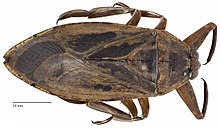
Back عيفسيات Arabic Belostomàtids Catalan Belostomatidae CEB Riesenwanzen German Belostomatidae Spanish انگشتگز Persian Belostomatidae French Belostomatidae Italian コオイムシ科 Japanese Belostomatidae Kazakh
| Belostomatidae | |
|---|---|

| |
| Lethocerus americanus | |
| Scientific classification | |
| Domain: | Eukaryota |
| Kingdom: | Animalia |
| Phylum: | Arthropoda |
| Class: | Insecta |
| Order: | Hemiptera |
| Suborder: | Heteroptera |
| Infraorder: | Nepomorpha |
| Family: | Belostomatidae Leach, 1815 |
Belostomatidae is a family of freshwater hemipteran insects known as giant water bugs or colloquially as toe-biters, Indian toe-biters, electric-light bugs, alligator ticks, or alligator fleas (in Florida). They are the largest insects in the order Hemiptera.[1] There are about 170 species found in freshwater habitats worldwide, with more than 110 in the Neotropics, more than 20 in Africa, almost as many in the Nearctic, and far fewer elsewhere.[2] These predators are typically encountered in freshwater ponds, marshes and slow-flowing streams. Most species are at least 2 cm (0.8 in) long, although smaller species, down to 0.9 cm (0.35 in), also exist. The largest are members of the genus Lethocerus, which can exceed 12 cm (4.5 in) and nearly reach the length of some of the largest beetles in the world.[1][3][4] Giant water bugs are a popular food in parts of Asia.[5]
- ^ a b P. J. Perez-Goodwyn (2006). "Taxonomic revision of the subfamily Lethocerinae Lauck & Menke (Heteroptera: Belostomatidae)". Stuttgarter Beiträge zur Naturkunde. Serie A (Biologie). 695: 1–71.
- ^ J.H. Thorp; D.C. Rogers, eds. (2015). Thorp and Covich's Freshwater Invertebrates: Ecology and General Biology. Vol. 1 (4 ed.). Elsevier. pp. 954–955. ISBN 978-0-12-385026-3.
- ^ Haddad, V.; Schwartz, E.F.; Schwartz, C.A.; Carvalho, C.N. (2010). "Bites caused by giant water bugs belonging to Belostomatidae family (Hemiptera, Heteroptera) in humans: A report of seven cases". Wilderness & Environmental Medicine. 21 (2): 130–133. doi:10.1016/j.wem.2010.01.002. PMID 20591375.
- ^ Randall T. Schuh; James Alexander Slater (1996). True Bugs of the World (Hemiptera:Heteroptera): Classification and Natural History (2 ed.). Cornell University Press. pp. 111–114. ISBN 978-0801420665.
- ^ Mitsuhashi, J. (2017). Edible Insects of the World. CRC Press. ISBN 978-1-4987-5657-0.